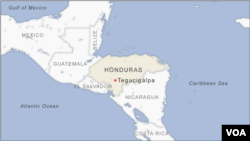The mother of a 17-year-old who died this week in U.S. immigration custody demanded answers from U.S. officials Friday, saying her son had no known illnesses and had not shown any signs of being sick before his death.
The teenager was identified as Ángel Eduardo Maradiaga Espinoza, according to a tweet from Honduras’ foreign relations minister, Enrique Reina. Maradiaga was detained at a facility in Safety Harbor, Florida, Reina said, and died Wednesday. His death underscored concerns about a strained immigration system as the Biden administration manages the end of asylum restrictions known as Title 42.
His mother, Norma Saraí Espinoza Maradiaga, told The Associated Press in a phone interview that her son "wanted to live the American Dream."
Ángel Eduardo left his hometown of Olanchito, Honduras, on April 25, his mother said. He crossed the U.S.-Mexico border some days later and on May 5 was referred to the U.S. Department of Health and Human Services, which operates longer-term facilities for children who cross the border without a parent.
That same day, he spoke to his mother for the last time, she said Friday.
"He told me he was in a shelter and not to worry because he was in the best hands," she said. "We only spoke two minutes. I told him goodbye and wished him the best."
This week, someone who identified himself only as one of her son's friends at the shelter called her to say that when he had awakened for breakfast, Ángel Eduardo didn't respond and was dead.
His mother then called a person in the U.S. who was supposed to have received Ángel Eduardo, asking for help verifying the information. Hours later, that person called her back saying it was true that her son was dead.
"I want to clear up my son's real cause of death," she said. He didn't suffer from any illnesses and hadn't been sick as far as she knew.
"No one tells me anything. The anguish is killing me," she said. "They say they are awaiting the autopsy results and don't give me any other answer."
No cause of death was immediately available nor were circumstances of any illness or medical treatment.
HHS said in a statement Friday that it "is deeply saddened by this tragic loss and our heart goes out to the family, with whom we are in touch." A review of health care records was under way, as was an investigation by a medical examiner, the department said.
White House press secretary Karine Jean-Pierre called the news "devastating" and referred questions about the investigation to HHS.
This was the first known death of an immigrant child in custody during the Biden administration. At least six immigrant children died in U.S. custody during the administration of former President Donald Trump, during which the U.S. at times detained thousands of children above the system's capacity.
HHS operates long-term facilities to hold children who cross the border without a parent until they can be placed with a sponsor. HHS facilities generally have beds and facilities as well as schooling and other activities for minors, unlike Border Patrol stations and detention sites in which detainees sometimes sleep on the floor in cells.
Advocates who oppose the detention of immigrant children say HHS facilities are not suited to hold minors for weeks or months, as sometimes happens.
More than 8,600 children are currently in HHS custody. That number may rise sharply in the coming weeks amid the shift in border policies as well as sharply rising trends of migration across the Western Hemisphere and the traditional spike in crossings during spring and summer.
Ángel Eduardo had studied until eighth grade before leaving school to work. Most recently he had been working as a mechanic's assistant. He had been a standout soccer player in Olanchito in northern Honduras since he was 7 years old, his mother said.
The teenager had hopes of reuniting with his father, who left Honduras for the U.S. years ago, and earning money to support her and two younger siblings still in Honduras, his mother said.
He had migrated with his mother's approval and financial support from his father in the United States, she said.










